Monitor engine speed item on the service data.
Specification :
650 ± 100 rpm (D-range)
720 ± 100 rpm (N-range)
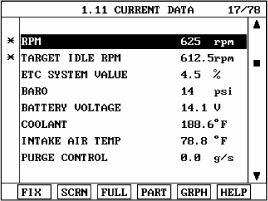
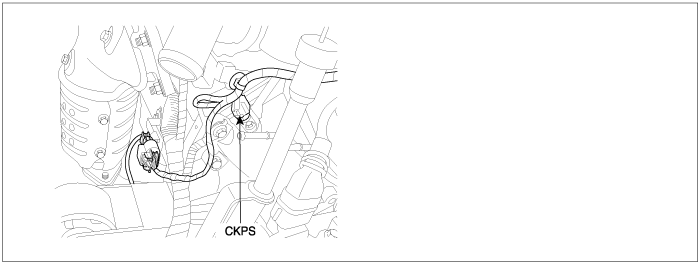
Crankshaft Position Sensor (58X) derives its name from the fact that current systems utilize a Crankshaft Position Sensor, coupled with a 58-tooth crankshaft wheel, to determine crankshaft angular position. Each edge of the wheel corresponds to a change in crank sensor output voltage as a tooth edge passes the sensor. The sensor will produce 58 pulses with one rotation of the crankshaft.
Checking reference signals from CKPS under detecting condition, if any signal is not detected for more than 0.15 sec., PCM sets P0335. MIL(Malfunction Indication Lamp) turns on when the malfunction lasts till consecutive 2 driving cycle.
Item | Detecting Condition | Possible cause | |||||
DTC Strategy | ● Check reference wave during cranking | ● Poor connection ● Open in harness ● CKP sensor ● PCM | |||||
Enable Conditions | ● IG "ON", Cranking or engine-off during driving ● No DTC related to CAM ● Camshaft position sensor state change | ||||||
Threshold value | ● No reference signal over 0.15 sec. | ||||||
Diagnosis Time | ● 0.15 sec. | ||||||
MIL On Condition | ● 2 driving cycles | ||||||
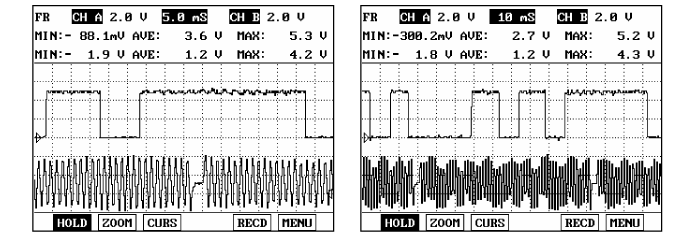
Resistance | 700 ± 70Ω |
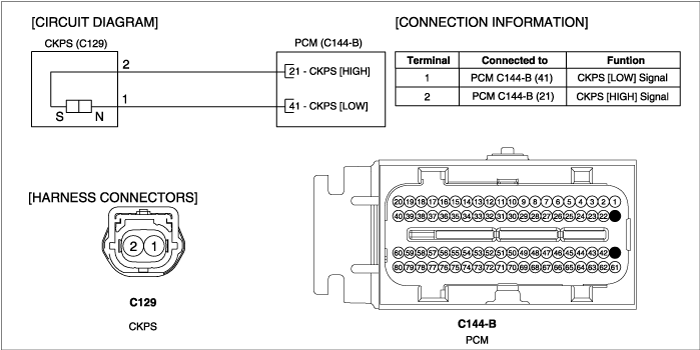
IG "OFF" & connect scantool.
ENG "ON" and warm -up the engine to normal operating temperature.
Monitor engine speed item on the service data.
Specification :
650 ± 100 rpm (D-range)
720 ± 100 rpm (N-range)

Is the service data displayed correctly ?

▶ Fault is intermittent caused by poor contact in the sensor’s and/or PCM’s connector or was repaired and PCM memory was not cleared. Thoroughly check connectors for looseness, poor connection, ending, corrosion, contamination, deterioration, or damage. Repair or replace as necessary and go to "Verification of Vehicle Repair" procedure

▶ Go to "Terminal and Connector Inspection" procedure
Many malfunctions in the electrical system are caused by poor harness and terminals. Faults can also be caused by interference from other electrical systems, and mechanical or chemical damage.
Thoroughly check connectors for looseness, poor connection, bending, corrosion, contamination, deterioration, or damage.
Has a problem been found?

▶ Repair as necessary and go to "Verification of Vehicle Repair" procedure

▶ Go to "Signal Circuit Inspection" procedure.
Check voltage
IG "OFF" and disconnect CKPS connector.
IG "ON" and ENG "OFF"
Measure voltage between terminal 1 of CKPS harness connector and chassis ground.
Measure voltage between terminal 2 of CKPS harness connector and chassis ground.
Specification : Approx. 1.4V

Is the measured voltage within specification?

▶ Go to "Component Inspection" procedure.

▶ Go to "Check open in harness" as follows.
Check open in harness
IG "OFF" and disconnect CKPS connector and PCM connector.
Measure resistance between terminal 1 of CKPS harness connector and terminal 41 of PCM harness connector.
Measure resistance between terminal 2 of CKPS harness connector and terminal 21 of PCM harness connector.
Specification : Below 1Ω
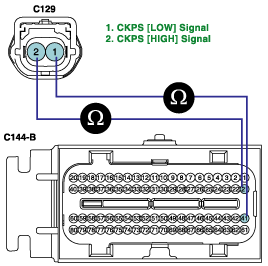
Is the measured resistance within specification?

▶ Go to "Component Inspection" procedure.

▶ Repair open in harness, and go to "Verification of Vehicle Repair" procedure.
Check CKPS
IG "OFF" and disconnect CKPS connector.
Measure resistance between terminals 1 and 2 of CKPS connector.(Component side)
Resistance | 700 ± 70Ω |
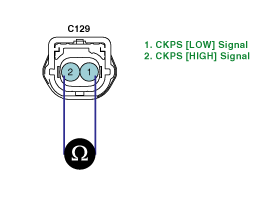
Is the measured resistance within specification?

▶ Go to "Check signal waveform of CKPS" as follows.

▶ Substitute with a known - good CKPS and check for proper operation. If the problem is corrected, replace CKPS and go to "Verification of Vehicle Repair" procedure.
Check signal waveform of CKPS
IG "OFF" and connect scantool.
ENG "ON" and Measure signal waveform at terminal 1 or 2 of CKPS.

Is the measured siganl waveform normal?

▶ Thoroughly check connectors for looseness, poor connection, bending, corrosion, contamination, deterioration, or damage. Repair or replace as necessary, and go to "Verification of Vehicle Repair" procedure.

▶ Substitute with a known - good PCM and check for proper operation. If the problem is corrected, replace PCM and go to "Verification of Vehicle Repair" procedure.
There is a memory reset function on scantool that can erase optional parts automatically detected and memorized by PCM. After testing PCM on the vehicle, use this function to reuse the PCM on the others
After a repair, it is essential to verify that the fault has been corrected.
Monitor and record the Freeze Frame Data for the Diagnostic Trouble Code(DTC) which has been diagnosed.
Using a Scantool, Clear the DTCs
Operate the vehicle within conditions noted in the freeze frame data or enable conditions
Monitor that all rediness test have been verified as " Complete "
Are any DTCs present ?

▶ Go to the applicable troubleshoooting procedure.

▶ System is performing to specification at this time.